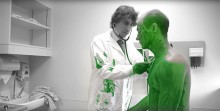Alex Gillis
In 2011, Dr. Seema Marwaha took a risk with an experimental video about hand washing. The two-minute film, “Wash your hands — it just makes sense,” depicted bacteria as green paint and showed a doctor with unwashed hands passing green gobs of the stuff from patient to patient. It was as gross as it was powerful. The film’s message was simple: wash your hands, because, as the video noted, antibiotic-resistant infections kill 8,000 patients a year in Canada.
“As an internal-medicine physician, I could have made a short, academic documentary, but I suspected that the experimental video would have more impact,” says Marwaha, who is an assistant professor of medicine at the University of Toronto. The video went viral, with 183,000 views. More than 40 hospitals asked for permission to screen it.
This September, Marwaha enrolled in the Fellowship in Global Journalism program at the Munk School of Global Affairs. Unique in Canada, the program helps specialists to become journalists, transforming them into specialized reporters. As with the 20 other fellows in the program, Marwaha wants to translate her knowledge into stories the general public can readily understand.
“The program attracts doctors, scientists, lawyers, economists, urban planners and a range of specialists,” says Robert Steiner, director of the program and a former Wall Street Journal reporter. “It’s designed to help professionals and specialists report from their fields and shape news reporting.”
This October, the fellows completed the first phase of the program – five weeks in a boot camp about the basics of great journalism. “We learned how to find interesting stories and how to pitch them, among other skills,” says Blair Bigham, another medical doctor in the program. Afterwards, the fellows began six months of part-time instruction and two years of mentoring to support their media freelancing.
“The most valuable thing about the Fellowship is the mentorship you get from the bureau chiefs,” says Linda van der Horst, who finished the program in the spring of 2016. She wrote an article for VICE News about Taiwan’s indigenous people. “The story exemplifies what I learned from the program,” says van der Horst, who now works in the Dutch foreign service and is a part-time freelance podcaster. “I covered an issue that the Taiwanese media hadn’t paid much attention to, and I brought it to an audience interested in transitional justice for indigenous people in Canada.”
The Fellowship gives her and the other fellows the tools to report on compelling stories. “Their knowledge allows them to notice things in their fields before conventional reporters do,” Steiner explains. “The program helps them to ask the right questions of the right people.”
And their approach is hands-on from day one. “The students, most of whom have masters or doctorates, work with writing and editing coaches, instead of professors in the traditional sense,” Steiner says. “They get feedback on their stories, instead of marks on assignments. And they publish or broadcast their work.”
“In a media industry where few outlets can afford a large staff of reporters, we’re training people to be specialist reporters and media entrepreneurs, so they’ll be in a position to pitch their own stories and launch their own media platforms,” Steiner adds.
The program is so successful that this year, the Munk School teamed up with the Rotman School of Management to create a new executive training program, called Communications and Advocacy in the Digital Age. The new program trains senior managers and executives to build deeper and longer-term media connections in a way that advances leadership goals. “It uses the same tools as in the Fellowship but for a different audience,” Steiner says.
Meanwhile, the Fellowship instructors use a similar approach in a media industry where the only rule is change. “They guide and coach you to report and write, but they’re also an incredible source of mental support,” says Linda van der Horst. “It’s a scary rollercoaster ride becoming a freelance journalist.”
October 26, 2016
